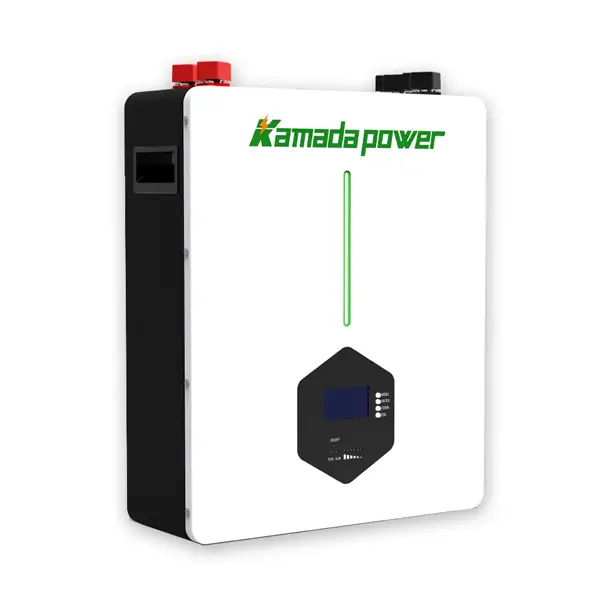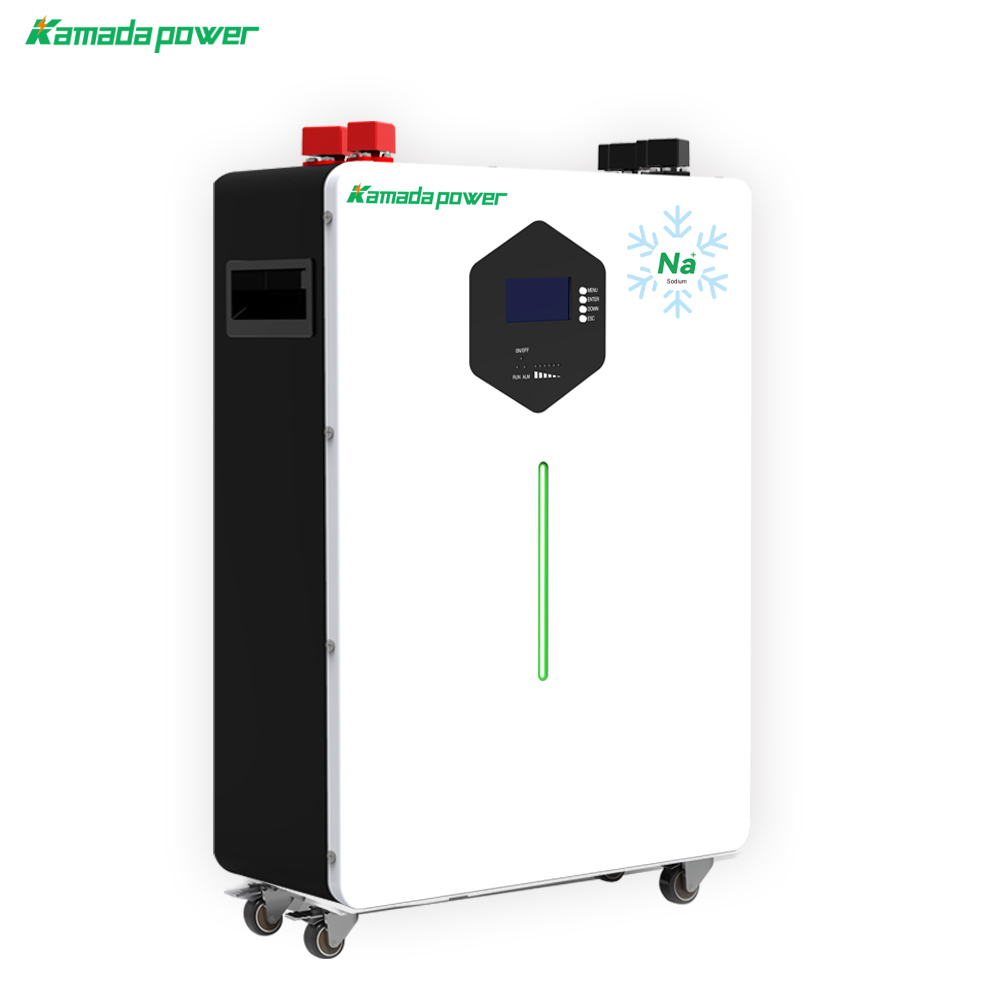Kaikki mitä sinun tarvitsee tietää Koti aurinkoakku Varastointi. Kello on kuusi iltapäivällä. Aurinko on laskenut, aurinkopaneelit ovat valmiit tältä päivältä, mutta talosi on vasta käynnistymässä. Ilmastointi on päällä, päivällinen on valmistumassa, auto latautuu. Vedät paljon sähköä verkosta, ja teet sen silloin, kun hinnat ovat korkeimmat.
On myös toinen skenaario: myrskyvaroitus ilmestyy puhelimeesi. Mietit, pysyykö sähköt päällä.
A koti aurinkoakku on vastaus molempiin ongelmiin. Kyse ei ole vain vihreästä energiasta. Kyse on siitä, ettei tarvitse olla riippuvainen sähköverkosta, että on olemassa todellinen varasuunnitelma ja että voi ottaa sähkölaskunsa takaisin hallintaansa.

Kamada Power 10kWh akun teho seinä kodin akun varastointi

Kamada Power 10kwh natrium-ioniakku kodin aurinkojärjestelmään
Miten kodin aurinkoakkujärjestelmät toimivat
Moderni kotiakkujärjestelmä ei ole vain akku. Muutamien keskeisten osien on toimittava yhdessä.
- PV-paneelit: Virtalähteesi. Ne istuvat katolla ja tuottavat tasasähköä.
- Invertteri/laturi: Tämä on asun todelliset aivot. Sen on muunnettava paneeleista ja akusta tuleva tasavirta talon käyttämäksi vaihtovirraksi. Sen on myös voitava toimia päinvastoin, ottaa halpaa verkkovirtaa (jos haluat) ja käyttää sitä akun lataamiseen. Monet uudet järjestelmät käyttävät Hybridi-invertteri joka tekee kaiken. Jos lisäät akun vanhempaan aurinkokennoasennukseen, käytät todennäköisesti niin sanottua akkua. AC-kytkentä järjestelmä, jossa on oma invertteri.
- Akkupaketti: Tänne energia varastoituu. Kyseessä ei ole koskaan yksi suuri kenno, vaan useiden pienempien akkukennojen muodostama kokonaisuus, jota hallitaan yhtenä yksikkönä.
- BMS (Battery Management System): Tämä on akun henkivartija. Se on pieni tietokone, joka tekee vain yhden asian: suojelee kennoja. Se tasapainottaa niitä, estää niitä latautumasta liikaa ja pitää lämpötilan kurissa. Rehellisesti sanottuna BMS on tärkein osa sekä turvallisuuden että pitkän käyttöiän kannalta.
- Seurantasovellus: Näet, mitä tapahtuu reaaliajassa. Näet, mitä paneelit tuottavat, mitä talo ottaa ja kuinka paljon säiliössä on jäljellä.
Näin se tapahtuu. Paneelit tuottavat 25 kWh energiaa. Kotisi käyttää vain 10 kWh. Loput 15 kWh latautuu akkuusi sen sijaan, että ne menisivät sähköverkkoon penniä vastaan. Sinä yönä perheesi käyttää 12 kWh energiaa. Tämä energia tulee akusta ilmaiseksi. Yksinkertaista.
Tässä on termi, joka sinun pitäisi tietää...Purkautumissyvyys (DoD). Se on vain asetus, joka estää akkua tyhjenemästä nollaan. 10 kWh:n akku, jossa on 90% DoD, antaa sinulle 9 kWh käyttökelpoista energiaa ennen kuin se pysähtyy. Tuon 10%:n puskurin jättäminen on yksinkertainen temppu, jolla on valtava merkitys akun terveydelle vuosien mittaan.
Tyypit Home Solar akut
Kemiaa sisällä koti aurinkoakku päättää melko pitkälti kaiken siitä, kuinka turvallista se on ja kuinka kauan se kestää.
- Litium-rautafosfaatti (LFP): Tämän haluat nykyään kotiakulta. Tärkeintä LFP:ssä on se, että se on uskomattoman vakaa. Se ei ylikuumene helposti, mikä on useimpien akkujen turvallisuusongelmien syy. Ne ovat turvallisia, kestävät hyvin pitkään ja voit sijoittaa ne autotalliin tai kellariin.
- Litium NMC (nikkeli-mangaani-koboltti): Näin on monissa sähköautoissa. Se sopii hyvin autoihin, koska se pakkaa enemmän tehoa pienempään tilaan. Kun akku vain seisoo autotallissa, tämä etu ei kuitenkaan ole yhtä tärkeä. Se tarvitsee monimutkaisemman jäähdytyksen, eikä sillä ole samanlaista turvallisuutta ja elinikää kuin kotikäyttöön tarkoitetulla LFP:llä.
- Lyijyhappo: Vanhan koulukunnan valinta. Ollaan rehellisiä, se on halpa aluksi, mutta siinä kaikki. Se on painava, tarvitsee oman tuuletetun tilan, eikä kestä kovin kauan. Se ei vain ole enää oikea työkalu työhön.
- Kehittyvät teknologiat: Muutamia uusia asioita on tulossa. Natriumioniakku Se lupaa LFP:n kaltaista turvallisuutta ilman litiumia. Saatat myös kuulla Virtausakut, jotka voivat kestää ikuisesti, mutta toistaiseksi ne ovat tarkoitettu suuriin kaupallisiin hankkeisiin, eivät koteihin.
| Ominaisuus | LFP (suositeltava) | NMC | Lyijyhappo (Legacy) |
|---|
| Kapasiteetti | Korkea | Erittäin korkea | Matala |
| Syklin käyttöikä | 4,000 – 8,000+ | 1,000 – 3,000 | 300 – 1,000 |
| Est. Kustannukset | Kohtalainen | Kohtalainen | Alhainen (etukäteen) |
| Turvallisuus | Erinomainen | Hyvä (tarvitsee hallinnointia) | Kohtalainen (tuuletus vaaditaan) |
| Huolto | Ei ole | Ei ole | Korkea (kastelu) |
Oikean akun valitseminen kotiisi
Kun valitset akkua, sinun on saatava kaksi numeroa oikein. Ne eivät ole sama asia.
Kapasiteetti (kWh) vs. teho (kW): Kriittinen ero
Yksinkertaisimmin voin ilmaista asian näin. Kapasiteetti (kWh) on kaasusäiliösi - se kertoo sinulle kuinka kauan kotisi voi toimia. Teho (kW) on moottorisi - se kertoo sinulle kuinka monta asiaa kotisi voi toimia samaan aikaan.
- Kapasiteetti (kilowattituntia, kWh): Kuinka kauan sen on kestettävä? Tämä on kysymys, johon kapasiteetti vastaa. Useimmissa kodeissa 10-20 kWh:n kapasiteetti riittää yön yli ja selviää tavallisesta sähkökatkoksesta.
- Teho (kilowattia, kW): Tässä on kyse isojen asioiden käsittelystä. Voiko se käynnistää ilmastointilaitteen tai kaivopumpun? Ne tarvitsevat ison virran. 5 kW:n akku voi käyttää valoja ja jääkaappia ilman ongelmia. Mutta saatat tarvita 7 kW:n tai jopa 10 kW:n tehon, jotta voit käsitellä isompia laitteita.
Tarvitset oikean tasapainon. Akku, jonka kapasiteetti on suuri mutta teho pieni, sammuu heti, kun yrität ajaa liikaa.
Kustannukset, ROI ja säästöpotentiaali
Hyvä on, suuri kysymys: mitä tämä maksaa minulle? Ammattimainen asennus 10-15 kWh:n järjestelmään maksaa todennäköisesti jostain seuraavista hinnoista $8,000 ja $15,000.. Tämä ennen kannustimia.
Liittovaltion verohyvitys 30% auttaa paljon. Ja osavaltiossasi saattaa olla omia alennuksia. Kaiken tämän jälkeen takaisinmaksuaika on tavallisesti välillä 6-10 vuotta alue. Se, kuinka nopeasti pääset sinne, riippuu muutamasta asiasta.
- Käyttövuorokohtainen (TOU) arbitraasi: Tämä on tärkein. Käytät omaa ilmaista aurinkosähköäsi, kun verkkosähkö maksaa omaisuuden. Tässä säästyy todellista rahaa useimmille ihmisille.
- Kysyntämaksujen alentaminen: Joillakin energialaitoksilla on nämä oudot maksut, jotka perustuvat suurimpaan yksittäiseen energiankäyttöhetkeen. Akku voi pienentää huippukulutusta ja poistaa nämä maksut.
- Virtuaalivoimalaitosohjelmat: Joillakin energialaitoksilla on ohjelmia, joissa ne maksavat sinulle siitä, että annat niiden lainata pienen osan akkusi tehosta sähköverkon hätätilanteissa. Se ei ole paljon rahaa, mutta se auttaa.
Perhe voi helposti säästää $50-$150 dollaria kuukaudessa vain pelaamalla tätä peliä.
Turvallisuus ja sertifioinnit
Turvallisuudesta ei voi tinkiä. Kaikilla kotiisi asennettavilla järjestelmillä on oltava oikeat sertifikaatit. Jos etsit vain yhtä, valitse tämä:
- UL 9540: Tämä on koko järjestelmän - akun, vaihtosuuntaajan ja ohjelmiston - sertifiointi. Se on tärkein asia, joka on nähtävissä teknisissä tiedoissa.
- UL 1973: Tämä kattaa itse akkumoduulien turvallisuuden.
- UL 1741: Tämä on invertteriä varten, jotta se voi liittyä verkkoon turvallisesti.
Tämän lisäksi itse asennuksen on noudatettava ohjeiden Kansallinen sähkölainsäädäntö (NEC). UL 9540 -luokiteltu LFP-järjestelmä, jonka on asentanut joku, joka tietää, mitä tekee, on erittäin turvallinen järjestelmä.
Todelliset hyödyt ja sovellukset
- Varavoima: Sähköverkko kaatuu, mutta elämäsi ei pysähdy. Ruoka jääkaapissasi on kunnossa, valot palavat ja Wi-Fi toimii.
- Pienemmät laskut: Ostat vain vähemmän sähköä energialaitokselta. Se on suojaus hintoja vastaan, jotka näyttävät aina nousevan.
- Energiaomavaraisuus: Oman sähkön tuottaminen tuo mielenrauhaa.
Parhaat käytännöt aurinkokennoakkujen kotikäyttöön
- Seuraa käyttöäsi: Käytä sovellusta oikeasti. Opit paljon siitä, miten kotisi käyttää energiaa, ja löydät todennäköisesti muutamia helppoja tapoja tehostaa energiankulutusta.
- Käytä älykkäitä tiloja: Järjestelmässäsi on niitä. "Itsekulutus" on päivittäistä säästöä varten. Etsi "Storm Watch" -tilaa - se on tarpeeksi älykäs käyttämään verkkoa akun lataamiseen täyteen, jos se näkee huonon sään olevan tulossa.
- Ajattele sijoittamista: Akut eivät pidä äärimmäisistä lämpötiloista. Autotalli tai kellari on yleensä paras paikka. Akun pitäminen poissa suorasta auringonpaisteesta tai pakkasesta auttaa sitä kestämään pidempään.
- Tee ohjelmistopäivitykset: Kun saat ilmoituksen laiteohjelmiston päivityksestä, tee se. Ne sisältävät usein tärkeitä turvallisuus- ja suorituskykyparannuksia.
Päätelmä
A koti aurinkoakku tekee aurinkopaneeleistasi kokopäiväisen ratkaisun. Saat säästöjä, saat varasuunnitelman ja voit käyttää kaiken tuottamasi sähkön.
Mikä on ensimmäinen askel? Ennen kuin soitat kenellekään, selvitä omat energiatottumuksesi. Ota mukaan pari viimeisintä sähkölaskuasi. Se on lähtökohtasi. Sen jälkeen voit keskustella hyvän asentajan kanssa järjestelmästä, jossa on oikeanlaiset ominaisuudet. kapasiteetti (kWh) ja teho (kW) tehdä kodistasi omavaraisempi.
Ota yhteyttä, ja asiantuntijatiimimme räätälöi sinulle sopivan aurinkokennoratkaisun.